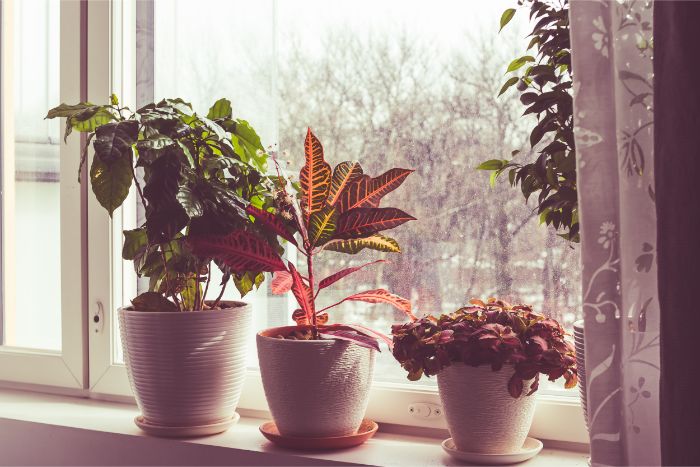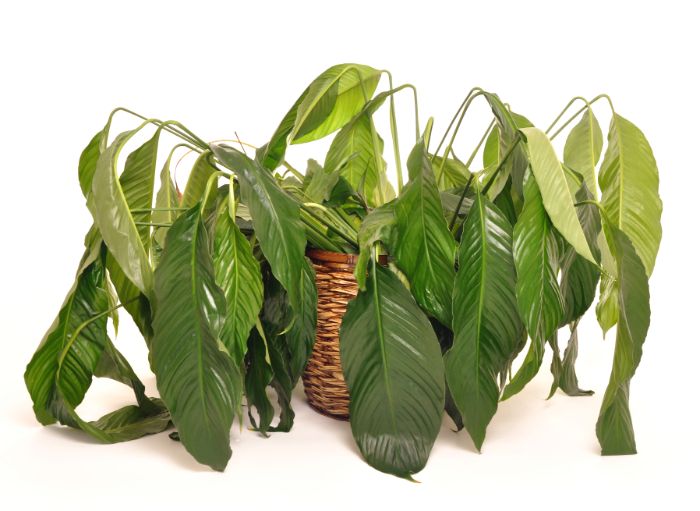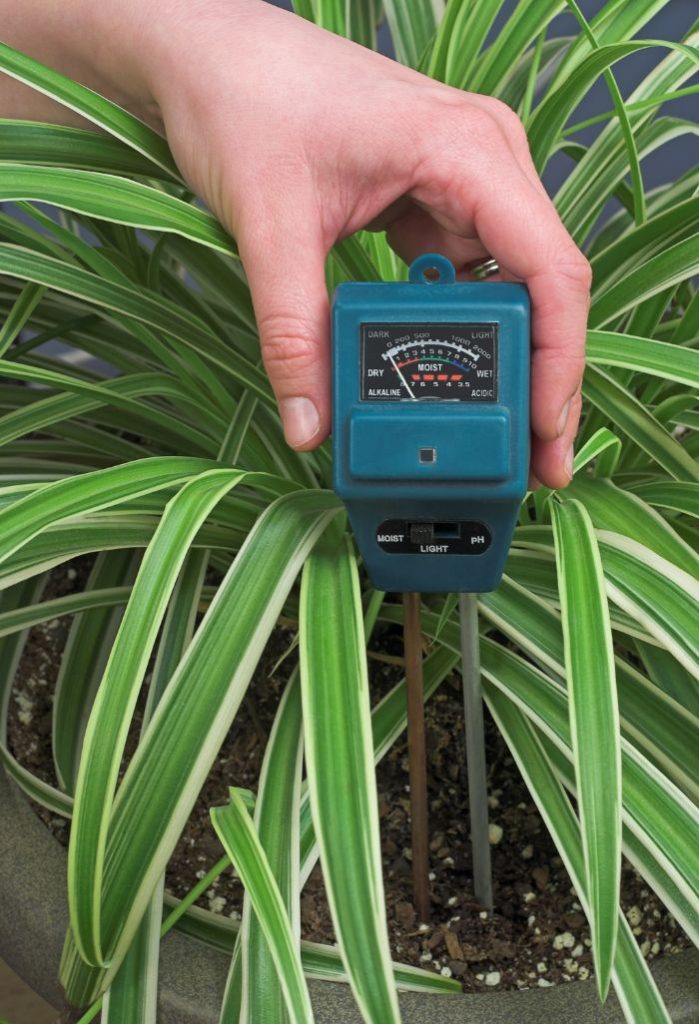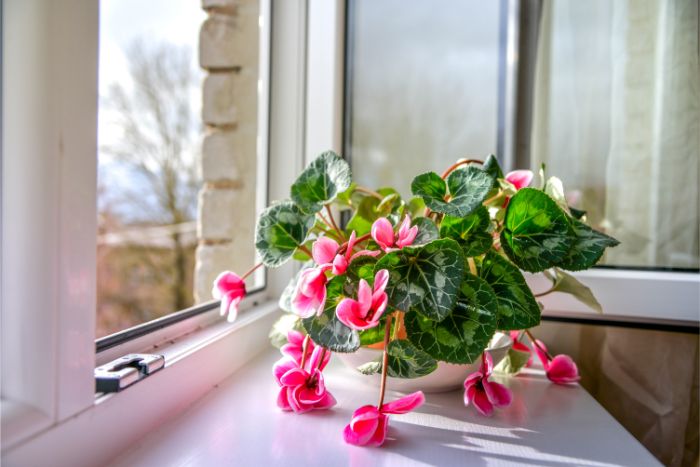One of the most difficult things about caring for house plants is knowing when to water them. It’s all too easy to water them too much or too little while trying so hard to nurture and care for them. This article is going to teach you how to tell when a houseplant needs water, rather than watering on a schedule and hoping for the best.
8 ways to tell when a houseplant needs water:
- Test the soil for dryness with your finger.
- Test the soil for moisture with a stick or skewer.
- Check for wilting or drooping leaves.
- Check for yellow or brown leaves.
- Check for dry leaves and leaf drop.
- Check the color of the soil.
- Test the weight of the pot.
- Use a soil moisture meter.
Learning how to properly assess when a houseplant needs water is one of the most important things you can learn to keep your houseplants thriving. I’m going to discus each of the things I use to help me know when and how much to water my indoor plants.
8 Ways To Tell When To Water An Indoor Plant
It always surprises me how easy it is to go wrong when watering houseplants. You get a beautiful plant home from the store and at first things are going so well. The foliage looks great and it blooms beautifully.
Before long, the plant starts to look a little unhappy and you wonder where you are going wrong. Well, by far the most common issue is watering.
I improved my skill in watering indoor plants by learning from my mistakes. Yes, I have overseen quite a few plant casualties. The most important thing I learned is that you need to assess your plants regularly and look for clues that they need water, rather than relying on bad advice to water your plants on a set schedule.
Follow these 8 tips and you will be well on the way to mastering the art of watering indoor plants.

1. Test The Soil For Dryness With Your Finger
One of the best ways to tell when your houseplant needs water is to keep an eye on the soil conditions. You do not need any fancy equipment or complicated techniques for doing this. A simple touch test can be enough to keep on top of watering requirements.
You can test the soil for dryness by pushing your finger into the soil every couple of days and feel the level of moisture. The top of the soil may look dry but it can be damp beneath, so it is important to push your finger down a few inches to feel for moisture under the surface.
The soil will typically dry from the surface downwards. You may need to water some plants once the surfaces dries out, others when the top inch has dried, and some other plants should only be watered once the soil is completely dry as far down as you can feel.
Many plant care guides, including most of my articles on this site, will advise when to water your plant based on the depth of dry soil.
Do not get overeager with watering. If you keep the soil wet/damp at all times, you stand the chance of encouraging root rot and that can lead to the demise of your house plant.
As with many things in life, watering houseplants is a balance. While overwatering is more common and typically causes more problems for indoor gardeners, underwatering is also a problem.
Once the soil has dried out to the recommended degree, you should water most houseplants thoroughly so that water drains from the bottom drainage holes. After this, the soil should be left to dry out to the appropriate level for the plant, regardless of how long this takes.
To put this in perspective, I have a Cast Iron Plant in a large planter in my hallway that only needs watered every 6-8 weeks, but I have a Ficus Bonsai on a bright windowsill that must be watered almost daily during the summer.
2. Test The Soil For Moisture With A Stick Or Skewer
Checking the moisture of the soil deep within the pot is important as the surface appearance of the soil can be deceiving. While the soil on the top might appear damp, it could be bone dry just below the surface or lower down where the roots are. Sometimes this happens when people sip-water their plants. This is where just a small amount of water is poured on the surface instead of soaking the soil.
More commonly, the surface will look dry even when the deeper soil is still very damp and the plant does not yet need watered.
You can use a stick or skewer to test the moisture levels in the soil. You should use an untreated and unstained stick, so opt for a chopstick or a popsicle stick.
You should insert the stick at least several inches into the soil, taking care to avoid the roots. The depth you insert the stick will depend on the plant. If your plant should be watered once the top half of the soil is dry, make sure to insert the stick at least half way down the soil.
You should take note how far you have inserted the stick, so you can properly assess the depth at which the soil becomes moist. You can put a pen mark on the stick at the surface of the soil, or just hold it at the soil surface, so you can be sure what depth the moisture in the soil starts at.
Leave the stick in the soil for 1-2 minutes so that the moisture has chance to mark the stick. Remove the stick from the soil and read the results.
Here is how to read the results:
- Look for a damp or wet mark on the side of the stick. This indicates that the soil is wet from this point. The depth of the wet mark will allow you to decide if your plant needs water, depending on the needs of the plant species.
- If the stick shows that the soil remains moist and watering is not required, repeat a stick moisture test in a few days again.
- If the stick shows a very vague moisture mark, you can use other measures to help you determine whether watering is required.
3. Check For Wilting And Drooping Leaves

Indoor plants wilt because the leaves lack sufficient water to be thick and plump with moisture. They may look as if they cannot hold their own weight and simply begin to wilt.
On the leaves of your house plant there are little pores called stomata. These are the pores that the plant uses to take in and release gases and moisture. When the plant does not have sufficient water, it will attempt to retain moisture by closing the stomata, halting the process of transpiration.
If the leaves are starting to wilt, you are already a bit late with watering, but it doesn’t mean that it is the end of the road for your houseplant. If you catch the problem in good time, you can most likely rectify it by watering the plant promptly. The leaves should perk up and start looking plump again quite quickly.
Be careful that you do not see wilting and drooping leaves and automatically believe that your houseplant needs water, as this is sometimes a sign of another, unrelated problem.
A bit of further investigation may be required as a plant can wilt and droop for other reasons too, which include overfeeding (excessive fertilizer), over-exposure to direct sunlight, disease or insect infestation, root rot, and overwatering too!
4. Check For Yellow Or Brown Leaves
If your house plant’s leaves start to change color, especially to a yellow or brown color, it can be a sign that it is not being watered correctly. In some cases, a thirsty house plant will start showing yellow or brown leaves.
If you do not notice right away, the leaves might even start getting dry or “crispy” on the outer edges. It is important to pay attention to the general daily health of your house plant, or you might miss the tell-tale signs that you are doing something wrong.
Be aware that yellow, brown and dried leaves are not always an indication of a plant needing water. Sometimes it can be an indication that the plant is suffering other issues such as over exposure to the sun, disease, or overwatering. You should use some of the other techniques to assess whether you are dealing with a watering issue or if there is a different problem.
5. Check For Dry Leaves And Leaf Drop
If you are not watering your house plant the right amount and at the right frequency, it may start to dry out which can lead to leaves dropping off. Many healthy plants will drop some older/mature leaves as a way of renewing their foliage, so you will need to look at the pattern and amount of leaf drop to determine if this is abnormal for your plant.
In the case of a plant not receiving enough water, there can be excessive leaf drop and both young and mature leaves will start drying out and dropping off. In fact, young leaves are often more likely to wilt and drop in an underwatered plant, so look for this pattern.
To make sure that you are not misreading the situation, check the soil to make sure that the it is actually very dry. In some instances, a plant can drop its leaves from overwatering too. If the soil is wet, it could be a sign that overwatering has led to root rot.
6. The Color Of The Soil Can Help You Tell When A Houseplant Needs More Water
The color of the soil can be a good indicator of just how much moisture is present in the soil. Wet soil naturally looks darker than dry soil, so can be a handy way to tell at a glance whether your plant is starting to dry out.
I like to use soil color as a quick test to see if any of my plants need a more detailed assessment. I can spot wet soil at a glance, so I know just from walking past my houseplants whether they are drying out or not. If I spot one where the soil looks a little dry, I can then assess it more closely, using some of the other techniques to determine whether I need to water the plant.
As I have quite a lot of houseplants, I often take a walk round my house and take note of any plants where the soil looks dry. I can then monitor these plants more closely over the next few days so that I water them at the perfect time.
7. Test The Weight Of The Pot By Picking It Up
Familiarizing yourself with the weight of your house plants can help you in the long run to determine when it is a good time to water the plant. When a house plant has moist soil, it will feel heavier than a pot with dry soil.
Once the water has evaporated from the house plant, you will feel a considerable weight difference in the pot. This can give you a rough idea of when the house plant needs water. As the pot gets lighter, the closer it is to needing more water.
The longer you have a plant, the better you will become at knowing just by the weight of the pot whether water is required. Along with the appearance of the soil, I use this measure as my first rough check of whether the plant needs water. If I am in doubt, I will use other measures to more closely assess it.
8. Use A Moisture Meter To Check The Soil Dryness

For some house plant lovers, the popsicle stick or chopstick test is enough to test the soil moisture. However, those who want a more accurate and scientific result to their moisture test like to invest in soil moisture meters.
A soil moisture meter can be quite useful. It certainly takes the guess work out of trying to schedule your house plant watering. Moisture meters usually have a scale that ranges from 1 to 10. 1 usually denotes very dry and 10 denotes very wet. Most also have color meters which help to determine when to water house plants and when it is best to hold off.
How to use a soil moisture meter to check the house plant’s soil:
- The first step is to choose a moisture meter. Most are inexpensive and some provide information on soil pH as well as moisture.
- The moisture meter reads soil moisture via the probe. Simply press the probe into the soil – while being careful not to jam it into the roots – to get a soil moisture reading. Only push the unit about ¾ of the way into the soil.
- You can remove the device from the soil and read the result after a few minutes. You will need to interpret the result depending on the water needs of your plant.
Reading Your Plant’s Watering Needs More Accurately
Rather than using any of the methods discussed above in isolation, it is best to use multiple techniques together to be sure that you are watering your houseplants at the right time.
For instance, a house plant with dry soil and wilting leaves is a plant that needs watering. However, a plant with wilting leaves and very wet soil will most likely be suffering root rot from overwatering.
Sometimes the symptoms that a plant presents can be indicative of a number of problems. Instead of looking for just one sign that the house plant needs water, take an overall look at the plant and its condition.
In addition to being able to assess when a houseplant needs water, it’s important to understand the factors that influence how much water they need. Pot size, soil type, temperature, humidity and airflow are just some of the factors that make a huge difference. I’ve written another article all about this aspect of houseplant watering over here.
Last Word
The most important thing when assessing when a houseplant needs water is to check each plant carefully, rather than relying on a watering schedule. Just get to know your indoor plants, and watch them over time. They will give you all the information you need to be able to get watering just right.
If you want to learn more about watering houseplants, check out my article about how often to water houseplants and this one about the best time of day to water indoor plants.

